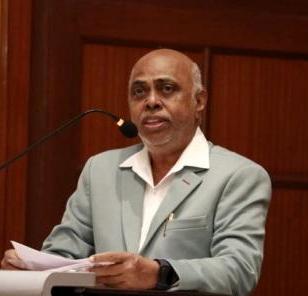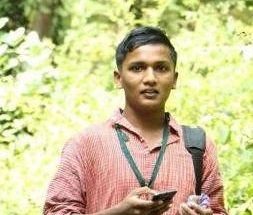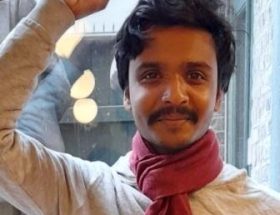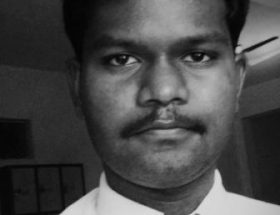(Speech made by G Karunanidhi translated from Tamil by Radhika Sudhakar)
I would like to go into how Social Justice was in operation in the past. We do not have to search for information elsewhere but can have it from the sections of the Constitution that was given by Dr Ambedkar. Under the Directive Principles of State Policy, Article 46 says: “The state shall provide with special care the educational and economic interest of the weaker sections of the people and in particular of the scheduled castes and scheduled tribes and shall protect them from social injustice and from all forms of exploitation.”
Based on this, in the Indra Sawhney case, one of the judges in the nine-member bench, P B Sawant, said in his judgment: “What should not be forgotten is that hitherto for centuries there has been cent percent reservation in practice in all fields in favour of the high caste and classes to the total exclusion of others. It was purely a class and caste-based reservation.” The judgment was passed on 1992, 14, November.
The Mandal Commission, which is the second backward class commission, headed by B P Mandal, appointed as per Article 340 of the Constitution, in its recommendation in para 13.9 says: “In fact, the Hindu society has always operated a very rigorous scheme of reservation which was internalized through the caste system. Ekalavya lost his thumb and Sambuka his neck for their breach of caste rules of reservation. The present furore against reservation for OBCs is not aimed at the principle itself but against the new class of beneficiaries as they are now clamoring for their share of opportunities which were all along monopolized by the higher castes.”
As per their notes and based on what is given in the Constitution, historically, reservation and social justice as prevailing yesterday in the period of the kings was based on law of Manu. Thus under no king was the common schooling system in place. The common schooling system came into effect only during the period of the British.
In Manu Sastra, Brahma, in order to save the world, divided people into the Varnas of Brahmin, Kshatriya, Vaysya, Shudra who were people born from the forehead, shoulder, thighs and feet. Sudras had to serve the other Varnas without jealousy. This was the law in place till the rule of kings. Article 340 of the Constitution says: “To a majority of people to whom education was denied socially, opportunities should be given.” In 1924, Satyanatha Iyer, who was an assistant professor at St Joseph college wrote a book titled “History of the Nayaks of Madurai.” He says in that book: “Robert De Nobli an Italian preacher who wrote on Madurai on 22 November 1610, throws some light on the educational organization of the Nayaks. There are more than 10,000 students distributed in different classes of two to three hundred. These students are all brahmins, for only they have the right to apply themselves to the study of the higher senses. In their educational policy therefore the Nayaks followed the ancient Hindu system of combining the religious and scientific studies and restricting them to the brahmins only.”
This is the view of social justice as prevailing in history.
Continuing after this in 1881 in Maharastra, Jothirao Phule presented evidence before the Hunter Commission. He said: “Education at all levels has become the exclusive right of Brahmins only. Hereafter schools should be opened only for Sudras. Brahmins should not be appointed in those schools even as teachers.”
In Madras Presidency, the Revenue Board of Madras 1854 gives an order. The order says: “The District Collector should be careful to see that subordinate appointments in their District were not monopolized by a few influential families. It is laid down that endeavour should always be to divide the appointments in each District among the principal castes.”
Following this, (in the Madras Province) in the 1871-72 population census, the statistics prove that all positions were occupied by the Brahmins only as upper castes. In 1881, a report on Government Jobs and Castes gives details that out of the total population, the 3.6 percent brahmins had 45 percent of jobs that earned over ten rupees. In Maharastra, Sahu Maharaj, in the Kolhapur Princely kingdom, was the first one to bring in reservation in 1902. In 1918, in the Mysore Princely kingdom, King Nalwadi Krishnaraja Wodeyar formed a Commission based on which Backward and Scheduled Caste people were given reservations. After that in Madras (now Chennai), the non-brahmin Manifesto of the Justice Party was published in 1916. It says: “In the Madras Executive Counsel, Sir Alexander Cordue, made a deposition before the government. The evidence that Cordue gave before the Public Service Commission in 1913 described in detail the relative position of the Brahmins and the Non-Brahmins in the public service of the province. Not certainly as a champion of the non-brahmin interests but with a view to show that if simultaneous examinations in English in India for admission into Indian Civil Service were to be introduced, the brahmins, whom he characterized as a small rigidly exclusive caste, would swamp the service.”
Cordue gave a lot of statistics while stating this and I would like to point to some of them. One of which is that in 1914 at Madras University the situation was that in the intermediate studies 775 students were Brahmins. In BA 210, BSc 159, MA 67 were only Brahmins. Justice party which came to know of the situation through Cordeu’s deposition, based the non-brahmin manifesto upon Cordeu’s evidence and started the non-brahmin movement. The evidence brought Justice Party to power. In a paper titled, “Dravidian movement in its pre-independence days,” written in the Economic and Political weekly, in 1979, N Ram, the former editor of The Hindu newspaper wrote: in 1912 in the Madras Province, out of the total Indians employed in higher positions in governance, Brahmins made up 55 percent as sub-collectors, 83.3 as Judges in subordinate court 72.6 percent in District Munsif. In higher education, between 1870-1918 brahmins in undergraduate studies made up 67-71 percentage of those who had studied.
After the statistics presented by Alexander Cordue formed the basis for Justice Party to come to power, in 1921 the (first) Communal GO (to provide reservation in Madras Province) was passed but the Justice party in power could not implement it. In 1928 they implement it giving 100 percent reservation including for Brahmins. This is unique across India – giving reservations for Brahmins, too. In the first (Communal) GO there is no mention of Backward classes but of non-brahmin(Hindu)s. As per that reservation, Non-Brahmin (Hindus) got 5 out of 12 seats, Brahmins got 2 seats, Muslims 2, Anglo-Indians and Christians got two and Scheduled Castes got one seat. This was amended in 21 November 1947 whereby, BCs got 2 out of 14 seats and brahmins too got 2 out of 14 seats. This is what the brahmin opposed and went to Court (after the Constitution came into effect) (Champakam Doraisamy case) and Periyar launched a massive struggle after 1950 which resulted in the first amendment to the Constitution, Article 15(4).
Tamil Nadu has been facing the biggest challenge to Social Justice. Because of 15(4) Amendment not just Tamil Nadu but also the whole of India got reservations for education. In independent India, in 1953 as per article 340, the Kaka Kalelkar Commission headed by brahmin Kalelkar gave its findings in 1955 but it was not taken for discussion as Kalelkar disagreed with the Commission’s findings. Hence, Nehru refused to place it before the Parliament and so it went into the dustbin without discussion. After 1978, the second Commission for backward classes was formed and gave its report in 1980. Even that was not placed before the Parliament for discussion.
There was another struggle by people, especially from Tamil Nadu, to get it placed before the Parliament. The Dravidar Kazhagam held 42 conferences, 16 demonstrations, the Dravidar Kazhagam activists even traveled upto Delhi and were jailed in Tihar for this. It was after that it came up for discussion in Parliament. Ram Vilas Paswan, Ram Bhagat Desingh, Chandrajit Yadav discussed the matter in Parliament. Then it was in 1990, under V P Singh that the reservation of 27 percent was given but still it could not be implemented. Immediately a case (Indira Sawhney case) went to the Supreme Court and there was a stay on its implementation. North India was in turmoil. The same people who accepted 10 percent reservation went on a rampage and V P Singh lost his Prime Ministership. For two years the case was in Court and on 16, November 1992, the Indira Sawhney case judgment came, which though gave approval for the 27 percent reservation, came up with a lot of hurdles for backward castes in its implementation.
The judgment came up with a new term “creamy layer” which stopped the advancement of backward castes. Also, it came up with 50 percent ceiling, which is nowhere in the Constitution. But the Court came up with this bar. This totally affected the opportunities of the backward castes. After that in 2007, when reservation in education came up as per the Mandal Commission recommendation and though passed in Parliament unanimously it was again stalled by the SC. The case went on for 1.5 years and it was only in April 2008 that it came into effect, but was again not implemented in whole by the Institutions run by the Union Government. IIT, IIM declared that they cannot give 27 percent reservation immediately but only 9 percent will be given. After dragging for years, it took about five or six years to implement the 27 percent reservation.
However, the 10 percent reservation faced no such bar and came into effect immediately. The Union Government immediately released funds in abundance to all the union government Institutions to implement this reservation. This has to be compared to the implementation of reservations for others. Even the All India pool of seats in Medical Institutions (under NEET) had no reservation (27 %) for backward castes initially. Tamil Nadu had to launch another struggle for social justice, and through the courts we had to get intervention and justice in that case. In practice what we see is that the 27 percent reservation for backward castes is not implemented in full. Even those in the general category are brought into the 27 percent reservation.
This case is before Justice Chandrachud presently and the situation today as far as social justice between yesterday and today is that it will take several years before social justice can be attained. However, as far as 10 percent reservation is concerned, this is the quickest-implemented reservation in the history of India. There were no evidences required, no Commission and no demands made either. But everything has come into effect immediately and passed in two days in both the houses of Parliament. The President signs it in two days and within a week orders have flown to all the educational Institutions and to Government departments to implement 10 percent reservation. Funds have been given immediately for its implementation.
Not just that, when this issue came before the Court, the SC changed the term of social and educational backwardness into economic basis. Three judges stated this with conviction that it must be on economic basis and two accepted it but pointed to legal discrepancies to oppose it and thus the law has come into effect by a 3:2 majority in court. What has already been put into effect and has had no stay has received the Court’s nod now.
The situation for BCs and SCs is this: 75 years after independence, the Group A positions in Union Government which is Secretary in 27 departments the number of OBCs is 0. In Group B it is zero out of 23, 41 Union Ministry not even 15 percent are OBC, out of 784 IIM Professors – SC- 8, ST- 2, OBC – 27, UC – 590. At IIT, out of 8856 positions, BC – 329, SC – 149, ST -21, UC is 4876, in the 41 Central Universities – out of 1125 Professors – OBC – 0, SC – 39, ST – 8. In the PMO Secretary out of 89 – OBC – 0, SC – 1, ST – 3.
Tamil Nadu has always been at the forefront of social justice struggle. The first amendment was because of Dravidar Kazhagam (DK) and Thanthai Periyar (founder of DK). In 1979 when the creamy layer definition was sought to be introduced in Tamil Nadu (for state reservations) with a Rs 9,000 salary ceiling, DK launched a massive agitation against it. Subsequently, it was stopped. In 1993 when the 69 percent (state) reservation in Tamil Nadu was in danger after a SC Judgement, the DK movement led by (president) K Veeramani gave the idea for a bill to be passed to J Jayalalitha (then CM) to be passed in the State Assembly and which subsequently can be secured by placing it under the 9th schedule. Only in TN has reservation been secured through the Constitution unlike in other states where there is only a Government Order.
Further, in the SC or in High Courts, except Madras High Court, Judges of OBC and SC are in single digits. In SC out of 32 Judges, only two are from SC. This is really the situation in 2022 after 75 years of independence when the Constitution is favouring Social Justice and reservation. The Union Ministry has given approval to privatize 182 Public sector industries which will totally destroy social justice. Tomorrow is posing that challenge. TN has to be in the forefront again and Aasiriyar K Veeramani has to bring together all forces and we have to struggle together to face this challenge.
(Translation of the Speech in Tamil delivered by G Karunanidhi, general secretary All India OBC Federation and Member, Monitoring Committee for Social Justice, Government of Tamil Nadu, on the topic ‘Social Justice – In the Past, Today and Tomorrow’, delivered at the Sir William Mayor Trust discussion on 29.11.2022 at the Madras University, History Department. The meeting was chaired by Dravidar Kazhagam president, K Veeramani.)
(Thanks to Kulukkai Channel for the video of the speech.)
~~~










